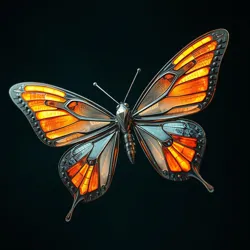Synthetic Lepidopterans

Synthetic Lepidopterans (SLs) are advanced biomechanical organisms that replicate and enhance the capabilities of natural butterflies and moths. Developed in 2158 through the Crystalline Wing Program, these artificial insects combine quantum computing, micro-fusion power, and advanced materials science.
Design and Structure
Synthetic Lepidopterans feature wings constructed from quantum-crystalline matrices that can change their optical properties on demand. Their bodies house miniaturized thoracic fusion cores and sophisticated neural networks capable of processing environmental data through quantum algorithms.
Wing Technology
The wings incorporate several revolutionary features: - Self-repairing crystalline structures - Photon manipulation arrays for camouflage - Electromagnetic field generators - Quantum sensor networks for environmental analysis
Applications
Environmental Monitoring
SLs excel at atmospheric data collection and environmental sensing through their advanced wing sensors. Swarms of synthetic butterflies can detect pollutants, analyze weather patterns, and track climate changes with unprecedented accuracy.
Communication Networks
Using their quantum-enabled wings, Synthetic Lepidopterans form vast aerial data networks capable of transmitting information through encrypted light patterns and quantum entanglement.
Agricultural Services
Specialized variants assist in crop pollination and pest control, working alongside other synthetic pollinators to maintain agricultural productivity.
Types and Classifications
Major categories include: - Quantum Monarchs - Specialized in long-range communication - Crystal Swallowtails - Focused on environmental analysis - Aurora Moths - Designed for nocturnal operations
Recent Developments
The latest generation features enhanced quantum processing cores that allow for more sophisticated swarm behaviors and improved data collection capabilities. Research continues into expanding their role in global environmental monitoring and communication networks.
See Also
- Biomechanical Flight Systems
- Quantum Wing Technology
- Synthetic Pollinator Networks
References
- Advanced Synthetic Biology Journal
- Quantum Lepidopteran Quarterly
- Biomechanical Engineering Review